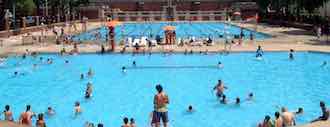By American Chemical Society —— Bio and Archives--March 8, 2017
 Even though Olympic swimmers have admitted doing it, peeing in the pool is not a condoned practice. Urine contributes to the formation of compounds in pool water that can be harmful to people's health. Now scientists are tackling a new way to monitor water quality: by measuring how sweet it is. Their report appears in ACS' journal Environmental Science & Technology Letters.
Recent studies have shown that nitrogenous compounds (e.g., urea) in urine and sweat react with chlorine to form disinfection byproducts (DBPs), including trichloramine, that can cause eye irritation and respiratory problems. Xing-Fang Li, Lindsay K. Jmaiff Blackstock and colleagues say this evidence has highlighted the need for improved understanding of pool chemistry to raise awareness and educate the public on the importance of swimming hygiene practices. To estimate how much urine — and potentially DBPs — might be in a given pool, Li's team needed to identify what compound might consistently be present in urine. So the researchers turned to the artificial sweetener, acesulfame potassium (ACE), which is marketed as Sunett and Sweet One. The sweetener, which is often used in processed foods like sodas, baked goods and even in other sweeteners, is widely consumed, chemically stable and passes right through the digestive tract and into consumers' urine.
The researchers developed a rapid, high-throughput analytical technique to test more than 250 water samples from 31 actively used pools and hot tubs in two Canadian cities, and more than 90 samples of clean tap water used to initially fill the basins. The concentration of ACE in the pools and hot tubs ranged from 30 to 7,110 nanograms per liter of water — up to 570 times more than the levels found in the tap water samples. Based on the concentrations of the sweetener, the researchers estimated that swimmers released more than 7 gallons of urine — enough to fill a medium-size trash bin — in a 110,000-gallon pool in one instance, and nearly 20 gallons in a 220,000-gallon pool (one-third the size of an Olympic-size pool) in another instance.
The authors acknowledge funding from the Natural Sciences and Engineering Research Council of Canada.
More: "Sweetened Swimming Pools and Hot Tubs"
Even though Olympic swimmers have admitted doing it, peeing in the pool is not a condoned practice. Urine contributes to the formation of compounds in pool water that can be harmful to people's health. Now scientists are tackling a new way to monitor water quality: by measuring how sweet it is. Their report appears in ACS' journal Environmental Science & Technology Letters.
Recent studies have shown that nitrogenous compounds (e.g., urea) in urine and sweat react with chlorine to form disinfection byproducts (DBPs), including trichloramine, that can cause eye irritation and respiratory problems. Xing-Fang Li, Lindsay K. Jmaiff Blackstock and colleagues say this evidence has highlighted the need for improved understanding of pool chemistry to raise awareness and educate the public on the importance of swimming hygiene practices. To estimate how much urine — and potentially DBPs — might be in a given pool, Li's team needed to identify what compound might consistently be present in urine. So the researchers turned to the artificial sweetener, acesulfame potassium (ACE), which is marketed as Sunett and Sweet One. The sweetener, which is often used in processed foods like sodas, baked goods and even in other sweeteners, is widely consumed, chemically stable and passes right through the digestive tract and into consumers' urine.
The researchers developed a rapid, high-throughput analytical technique to test more than 250 water samples from 31 actively used pools and hot tubs in two Canadian cities, and more than 90 samples of clean tap water used to initially fill the basins. The concentration of ACE in the pools and hot tubs ranged from 30 to 7,110 nanograms per liter of water — up to 570 times more than the levels found in the tap water samples. Based on the concentrations of the sweetener, the researchers estimated that swimmers released more than 7 gallons of urine — enough to fill a medium-size trash bin — in a 110,000-gallon pool in one instance, and nearly 20 gallons in a 220,000-gallon pool (one-third the size of an Olympic-size pool) in another instance.
The authors acknowledge funding from the Natural Sciences and Engineering Research Council of Canada.
More: "Sweetened Swimming Pools and Hot Tubs"The Comment section of online publications is the new front in the ongoing Cancel Culture Battle.
Big Tech and Big Media are gunning for the Conservative Voice—through their Comment Sections.
Canada Free Press wishes to stay in the fight, and we want our fans, followers, commenters there with us.
We ask only that commenters keep it civil, keep it clean.
Thank You for your patience and for staying aboard the CFP ‘Mother Ship’.
READ OUR Commenting Policy